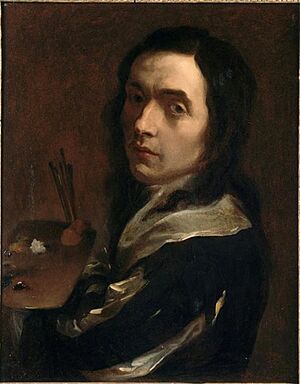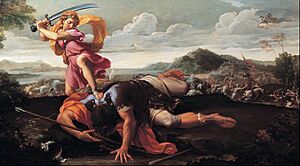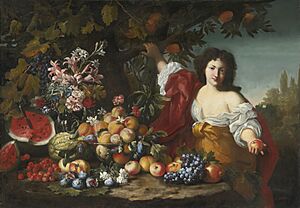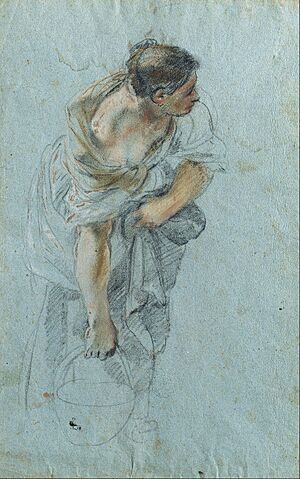Guillaume Courtois facts for kids
Guillaume Courtois (pronounced GEE-ohm Koor-TWAH), also known as Guglielmo Cortese (Goo-LYEL-mo Kor-TAY-zeh) or Il Borgognone ('the Burgundian'), was a talented painter, draughtsman, and etcher. He was born in 1628 and passed away in 1679. Guillaume was mainly active in Rome, Italy, where he painted historical and religious scenes. He was very popular and worked for important people. His brothers, Jacques Courtois and Jean-François Courtois, were also painters.
Contents
Life of Guillaume Courtois
Guillaume Courtois was born in a place called Saint-Hippolyte, which is now in France. His father, Jean-Pierre Courtois, was also a painter. We don't know much about Guillaume's early life. However, it's thought that his father taught him how to paint.
Around 1636, when Guillaume was still a child, his family moved to Italy. They traveled to many Italian cities like Milan, Bologna, Venice, Florence, and Siena.
Guillaume Courtois spent most of his life working in Rome. Some art historians believe he settled in Rome by 1638. There, he might have joined the studio of a famous painter named Pietro da Cortona. He learned by drawing from real life and copying works by other great artists like Giovanni Lanfranco and Andrea Sacchi. He also studied the style of painters from Bologna, like Guercino. This helped him develop a classic and clear painting style.
Another idea is that Guillaume stayed with his brother Jacques until the late 1640s. According to this idea, he only started working with da Cortona in 1656. Guillaume Courtois died in Rome in June 1679 from a condition called gout.
Two of his students were Jean-Blaise Chardon and Antonio Dupré.
What Guillaume Courtois Painted
General Works
Guillaume Courtois was mostly known for his "history paintings." These are large paintings that show scenes from history, the Bible, or mythology. He also painted "staffage," which means adding small figures to landscapes painted by other artists.
Sometimes, people called him a "battle painter." This is because he helped decorate a chapel for the Jesuits in Rome. He worked on this project with his brother Jacques, who was very good at painting battle scenes. Jacques painted the battles in the backgrounds. Guillaume painted scenes that showed victories believed to be helped by the Virgin Mary. These included Heraclius defeats the armies of Chosroes and The Battle of Louis IX of France.
Guillaume's early drawings show battle scenes, meaning he was first influenced by his brother. He also painted a few portraits and worked with other artists on everyday life scenes.
His first big public jobs were frescoes (wall paintings) for the San Marco, Rome church. The famous painter Pietro da Cortona recommended him and his brother for this job. Guillaume also painted The Battle of Joshua for Pope Alexander VII's gallery in the Quirinal Palace. He painted The Martyrdom of St Andrew for the main altar of the Sant'Andrea al Quirinale church.
These early paintings show the influence of Cortona. They also show the Baroque style of Agostino Carracci, but with a more energetic touch like Giovanni Lanfranco's work. These influences made his paintings full of strong shapes and bright colors, which became his signature style. He also learned from the style of Pier Francesco Mola. He worked with Mola and other artists on decorating the Valmontone Palace around 1658-1659.
In 1661, he painted an Assumption for a church in Castelgandolfo.
In his later works, he was also influenced by Carlo Maratta. Maratta was an artist who mixed the Baroque and Classicist styles. You can see this in the gentle faces of the women in paintings like the Madonna of the Rosary. He painted this in 1666 for the St. George Church in Monte Porzio Catone.
Working with Others
Guillaume Courtois often worked with his brother Jacques. He also worked with Abraham Brueghel, a Flemish painter known for still life paintings. For example, in the painting Still life of fruits and flowers with a figure, Brueghel painted the fruits and flowers, while Courtois painted the person.
He also worked with Bernini, a very famous sculptor and architect. Bernini admired Courtois's work and often suggested him for painting jobs. Courtois also frequently collaborated with Carlo Maratta.
In 1653, Courtois painted figures like St. Eustace and the Good Samaritan in four large landscape paintings by Gaspard Dughet. This was one of Courtois's earliest known collaborations. The next year, Courtois and Dughet worked together again for the same person, painting for the Palazzo Pamphilj.
His Drawings
Guillaume Courtois was a very skilled artist when it came to drawing. He left behind many "preparatory studies," which are drawings he made to plan his paintings. You can find many of these drawings in places like the Istituto Nazionale per la Grafica.
His preparatory drawings were usually made with chalk. His designs for whole compositions were often done with pen and ink. The chalk drawings for his fresco The Martyrdom of St Mark are very well done. They show his smooth technique and how well he understood shapes and light and shadow (called chiaroscuro).
See also
 In Spanish: Guillaume Courtois para niños
In Spanish: Guillaume Courtois para niños





